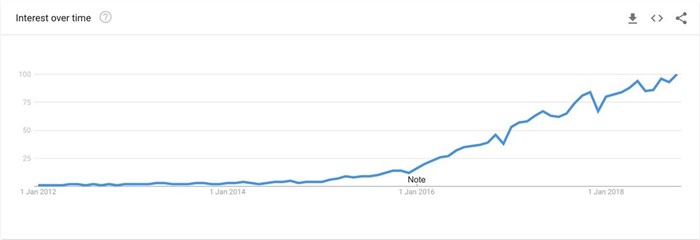#BizTrends2019: Influencer marketing goes mainstream. And matures.

Increase in searches for “influencer marketing” worldwide:

We’re seeing a rise in this marketing strategy because it delivers to the bottom line. Influencer marketing as a digital strategy is gaining traction because — if done well — influencer marketing can drive massive sales.
Want an example of how well influencer marketing can work? Then look to China where 26-year-old Yiang Xia-Sunny sells her fashion along with make-up and other beauty products through Alibaba's Taobao, an online marketplace. Known as a ‘Wǎnghóng’, during a recent online shopping festival known as ‘Singles Day’ she achieved sales of some 2.7m yuan (US$551,000).
This young influencer spends hours daily, nurturing her 3-million plus fans on Weibo, the micro-blogging platform where she’s known as 杨霞-Sunny, when she’s not negotiating deals with big brands, or speaking to suppliers about the brands she’s developed. A lot of 杨霞-Sunny’s time is spent tending to her online store.
1. Integrated influencer marketing delivers the best results
The most significant trend for influencer marketing for 2019 is one of integration. Study the Wǎnghóng phenomenon and discover the magic that underpins it — a massive ecosystem designed to empower sales. Influencer marketing works best in an integrated digital system designed to serve the customer.
The big lesson from China is that this ecosystem is revolutionising online sales by making it as easy as possible for e-commerce to happen. This by empowering massive e-commerce giants like Alibaba and Tencent to thrive, while helping Wǎnghóng to do what they do best. To sell and to grow.
Here are four more trends, which can also be embraced as strategies to ensure that influencer marketing works for your brand.
2. Where’s the bottom line?
Influencer marketing is currently faced with recessionary market forces. Clients want to see ROI. Metrics used in the past — like reach — will not be attractive unless these are directly linked to better business returns.
3. Better metrics
Traditionally marketers and advertisers have used reach as the dominant metric, and this may work in traditional media. But digital is a whole different ballgame; new technologies and algorithms provide more sophisticated measures, deeper insights and more targeted analysis. It’s no longer about audiences, but it’s all about how influence happens in networks.
4. Focusing on networks
Influencer marketing 1.0 was nothing more than celebrity endorsement. Version 1.1 was the rise of the Youtube stars, whose celebrity status was created by the influence they wielded. Now we’re talking influencer marketing 2.0, where technology allows us to identify tiers of influencers within social networks, in the form of groups of individuals who naturally engage with certain brands. Now brand owners can form personal relationships with those influencers and create tightly focused campaigns using their networks.
5. Rise of the new influencers
At a certain level, expect to see influencers become involved in the creation of products, especially as manufacturing becomes more streamlined. With shorter runs of bespoke products, for example, influencers can tout their exclusivity, while brands can grow their social cachet. Specialised, exclusive events that revolve around influencers and their networks serve the same purpose.














